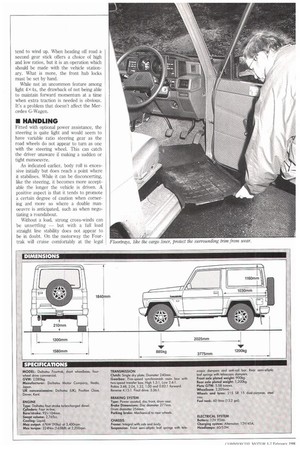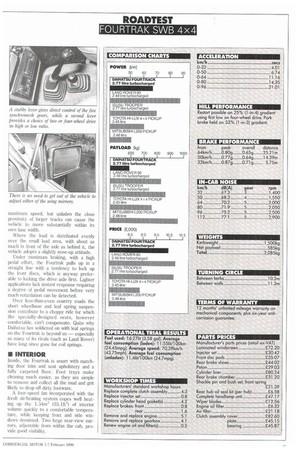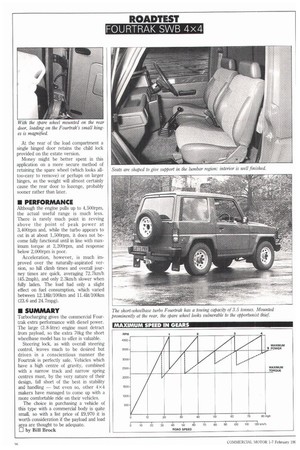FRISKY
Page 34

Page 36

Page 37

Page 38

If you've noticed an error in this article please click here to report it so we can fix it.
FOUR"'
Despite t e furore over alle•edly unstable Japanese 4x4s, Daihatsu's short-wheelbase Fourtra has acceptable handlin., combined with much-improved serformance.
• As it turned out, the adverse publicity that light 4x4s of eastern origin received last year was unwarranted. Tests carried out by the Government's Transport and Road Research Laboratory confirmed that no one model was consistently better or worse than any other vehicle of its type (well, they would have told us if that were not so, wouldn't they?).
Daihatsu, with one of the most comprehensive ranges of four-wheel-drive vehicles in the UK, is understandably sensitive about stability matters. To allay any fears, it has collaborated with the Department of Transport to produce the Guide to Safer 4x4 Motoring. This is full of useful tips but makes the point that due to the Fourtrak's high centre of gravity (which is an unavoidable result of its high ground clearance) it cannot match the stability expected of conventional passenger cars. As a result, Daihatsu advises that on-road cornering speeds should be moderated, and off-road transverse slopes should be negotiated with care.
Since the Fourtrak's debut in 1984, the country set has taken the estate version to their hearts; it is equally at home at point-to-point meetings as on a shopping trip down the Kings Road. However, the short and long-wheelbase models both have a more practical role as working commercial vehicles.
• DRIVELINE
The latest addition to the range, the short-wheelbase commercial, benefits from the turbocharging of its 2.77-litre four-cylinder diesel engine, which has boosted the power output by about 20% to 67kW (90hp) at 3,400rpm, and torque by 30% to 224Nm (165Ibft) at 2,200rpm. This still does not match the power of either its two main competitors from Land Rover and Isuzu.
The wheelbase has been cut by 325mm, resulting in a 350mtn reduction in platform length. By way of compensation, the process has made it lighter, so the payload is up to 585kg — 70kg more than with the long-wheelbase version — within an all-up weight of 2,085kg. This allows for a towing capacity of 3.45 tonnes. Isuzu and Land Rover, however, both offer more payload in this type of vehicle.
The high ground clearance of 210r= enhances the Daihatsu's approach and departure angles so necessary with a fourwheel-drive with any pretentions to offroad capability.
With a five-speed synchromesh gearbox and a two-speed transfer box, the Fourtrak can boast 10 forward ratios. In the lowest gear Daihatsu claims a gradeability of almost 45% (1-in-1). Our tests did not go quite so far, but we can confirm it will climb a 33% (1-in-3) gradient with a full load, and restart on a 25% (1-in-4) hill. The limiting factor between rolling and static gradeability is the clutch.
Four-wheel-drive is not recommended for normal road running, because on smooth surfaces the transmission may po. tend to wind up. When heading off road a second gear stick offers a choice of high and low ratios, but it is an operation which should be made with the vehicle stationary. What is more, the front hub locks must be set by hand.
While not an uncommon feature among Light 4x4s, the drawback of not being able to maintain forward momentum at a time when extra traction is needed is obvious. It's a problem that doesn't affect the Mercedes G-Wagen.
• HANDLING
Fitted with optional power assistance, the steering is quite light and would seem to have variable ratio steering gear as the road wheels do not appear to turn as one with the steering wheel. This can catch the driver unaware if making a sudden or tight manoeuvre.
As indicated earlier, body roll is excessive initially but does reach a point where it stabilises. While it can be disconcerting, Like the steering, it becomes more acceptable the longer the vehicle is driven. A positive aspect is that it tends to promote a certain degree of caution when cornering and more so where a double manoeuvre is anticipated, such as when negotiating a roundabout.
Without a load, strong cross-winds can be unsettling but with a full load straight line stability does not appear to be in doubt. On the motorway the Fourtrak will cruise comfortably at the legal A stubby lever gives direct control of the five synchromesh gears, while a second lever provides a choke of two or four-wheel drive in high or low ratio.
maximum speed, but unladen the close proximity of larger trucks can cause the vehicle to move substantially within its own lane width.
Where the load is distributed evenly over the small load area, with about as much in front of the axle as behind it, the vehicle adopts a slightly nose-up attitude.
Under maximum braking, with a high pedal effort, the Fourtrak pulls up in a straight line with a tendency to lock up the front discs, which is anyway preferable to locking the drive axle first. Lighter applications lack instant response requiring a degree of pedal movement before very much retardation can be detected.
Over less-than-even country roads the short wheelbase and leaf spring suspension contribute to a choppy ride for which the specially-designed seats, however comfortable, can't compensate. Quite why Daihatsu has soldiered on with leaf springs on the Fourtrak is beyond us especially as many of its rivals (such as Land Rover) have long since gone for coil springs.
• INTERIOR
Inside, the Fourtrak is smart with matching door trim and seat upholstery and a fully carpeted floor. Foot trays make cleaning much easier, as they are simple to remove and collect all the mud and grit likely to drop off dirty footware.
A four-speed fan incorporated with the fresh air/heating system copes Well heating up the 1.54m' (55.1ft3) of interior volume quickly to a comfortable temperature, while keeping front and side windows demisted. Two large rear-view mirrors, adjustable from within the cab, provide good visibility.
At the rear of the load compartment a single hinged door retains the child lock provided on the estate version.
Money might be better spent in this application on a more secure method of retaining the spare wheel (which looks alltoo-easy to remove) or perhaps on larger hinges, as the weight will almost certainly cause the rear door to lozenge, probably sooner rather than later.
• PERFORMANCE
Although the engine pulls up to 4,500rpm, the actual useful range is much less. There is rarely much point in revving above the point of peak power at 3,400rpm and, while the turbo appears to cut in at about 1,500rpm, it does not become fully functional until in line with maximum torque at 2,200rpm, and response below 2,000rpm is poor.
Acceleration, however, is much improved over the naturally-aspirated version, so hill climb times and overall journey times are quick, averaging 72.71un/h (45.2mph), and only 2.3km/h slower when fully laden. The load had only a slight effect on fuel consumption, which varied between 12.181it/100km and 11.41it/100km (23.6 and 24.7mpg).
• SUMMARY
Turbocharging gives the commercial Fourtrak extra performance with diesel power. The large (2.8-litre) engine must detract from payload, so the extra 70kg the short wheelbase model has to offer is valuable.
Steering lock, as with overall steering control, leaves much to be desired but driven in a conscientious manner the Fourtrak is perfectly safe. Vehicles which have a high centre of gravity, combined with a narrow track and narrow spring centres must, by the very nature of their design, fall short of the best in stability and handling — but even so, other 4x4 makers have managed to come up with a more comfortable ride on their vehicles.
The choice in purchasing a vehicle of this type with a commercial body is quite small, so with a list price of £9,970 it is worth consideration if the payload and load area are thought to be adequate.
LI by Bill Brock
































































































































